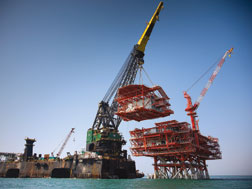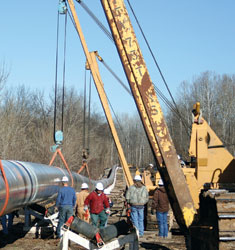 McDermott International, Inc. Firms expect projects to move further offshore as the thirst for oil continues.
|
When President George W. Bush earlier this year said that America is “addicted to oil,” it was not news to the contractors who build drilling platforms, pipelines, refineries, and downstream facilities for oil producers. Those contractors are pushed to the limit to keep pace with growth in the oil and natural gas market as producers scramble to provide America’s oil fix amid soaring crude prices from abroad and filled-to-capacity domestic refineries.
It is almost impossible to view the domestic oil construction market as independent from the global oil construction market, as many projects around the Gulf of Mexico, Canada’s oil sands and Alaska’s oil reserves are being driven by global supply dynamics. Outstripped by demand, oil producers are clamoring to boost supply through domestic drilling and new technologies to enhance extraction of crude from shale fields and Canada’s oil sands in Alberta.
“There is a lot of activity,” says Rob Smith, senior vice president of energy and chemicals for Denver-based CH2M-Hill Cos. “Projects now emerging are centered around the need to boost domestic supply.”
The Gulf of Mexico continues to provide a steady source of work for construction firms. Earlier this year, oil producers placed more than $70 billion in bids for the right to drill on federal lease tracts off the coasts of Louisiana, Mississippi and Alabama, and in the eastern and central Gulf of Mexico.
For contractors focused on drilling projects, work is going farther offshore into deeper waters, and is evolving to include floating production systems. “With oil over $100 a barrel, our customers have significant incentive to get projects on-line and producing sooner rather than later, which is driving our work,” says Bruce Wilkinson, president and CEO at Houston-based McDermott International Inc. Wilkinson says although his firm’s current oil and gas backlog involves the engineering, construction and installation of traditional fixed platforms and the associated pipelines, he anticipates that oil and gas projects “will continue to move to deeper and more remote waters, which over time will cause our backlog to shift toward more floating production systems and subsea production systems.”
In the drive to reduce the amount of foreign crude on which the U.S. depends, a key trend among oil producers is a push to boost capacity for transporting and refining heavy crude, which is abundant in Canada’s oil sands and in shale fields in Texas, Oklahoma, the Dakotas and the Rocky Mountain region. The shift from lighter, imported crude to heavy crude is the prevailing theme in the oil industry currently and is driving a host of projects in the domestic oil market, contractors say.
“There is new technology that makes it possible to get gas and oil out of tight locations” such as within pockets of shale, says Smith. For example, horizontal drilling allows drillers to exploit natural fracture lines in shale, providing access to trapped oil and gas. Drillers also are increasingly using “fracturing” techniques, which involve pumping water into fracture lines to break open new access points to untapped reserves. “New fracturing technology and horizontal drilling allows access to gas and oil reserves locked in the shale. It’s a whole new play opening up and there is a lot of activity around it,” Smith says.
|
Smith also points to a spate of projects to build benzene solution units at refineries to aid in the refining of heavy crude. “These refinery upgrades are emerging as producers need to accommodate increasing volumes of heavy crude coming from Canada’s oil sands,” says Smith.
“The trend is to go to heavy crude,” says Tom O’Brien, CEO at Indianapolis-based BMW Constructors Inc. “They are shifting refineries to refine heavy crude which requires higher temperatures and higher pressure.”
One the heels of drilling expansions are pipeline projects needed to transport the crude and gas. Houston-based Willbros Group Inc., a leading pipeline designer and constructor, has five major pipeline projects in various stages of planning and construction under way for undisclosed clients. The projects include two 42-in.-dia pipeline projects, stretching a total of nearly 550 miles and together costing about $500 million, and three others for which the “scope is not fully defined,” says John Allcorn, Willbros. executive vice president. “Most are related to gas as producers want to increase capacity of liquefied natural gas, and other opportunities are coming from [gas reserves] in northern Texas and southern Oklahoma as they look to send large volumes of gas to the eastern region.”
Dozens of major other pipeline projects are in the works, including a proposed $5.2-billion, 2,148-mile pipeline from Hardisty, Alberta, to Wood River and Patoka, Ill., and on to Cushing, Okla., and about $20 billion in pipeline projects stemming from Alberta’s oil sands. The Alberta projects include a pipeline from Alberta to the Texas coast.
 Wilbros Group Contractors have scored in getting natural gas to market.
|
One of the biggest proposed pipeline projects is the McKenzie Valley project, a proposed $17-billion project to transport natural gas from the Beaufort Sea to the U.S. market through Alberta. The 1,200-kilometer pipeline is planned to be built before the proposed Alaska pipeline project gets off the ground. In August, the Alaska State Senate voted to give Canada-based TransCanada Corp. the go-ahead on the 1,715-mile, $26-million-plus Alaska pipeline project that would bring North Slope natural gas to market. That project is expected to be completed in about 10 years.
As charged as the oil and gas market is, there still are pitfalls. Due to materials price volatility, owners and contractors are working out contract difficulties. “We have had to move away from fixed-price contracts,” says Mike Collier, vice president at Willbros. “It is impossible to estimate what prices will be a year from now. It used to be that 80% of our contracts were fixed-price, but now about 75% of contracts are cost-reimbursable. Almost all our contracts now are hybrids to protect against cost escalation for labor and materials. It’s the way it has to be done now.”
Although they are uncertain of how global dynamics, labor availability and materials costs will evolve, clients are grappling with new ways to boost domestic energy production and contractors are optimistic about the market’s long-term health. “I can’t say how long it will last, but there is work ahead for the next eight to 10 years,“ says Allcorn.
While contractors in other construction sectors are eyeing an eventual slowdown to the building boom, contractors in the oil and gas markets see it a bit differently. “We are bullish,” says Smith. “We are very optimistic about this market’s future.”
 Related Links:
Related Links:
Post a comment to this article
Report Abusive Comment